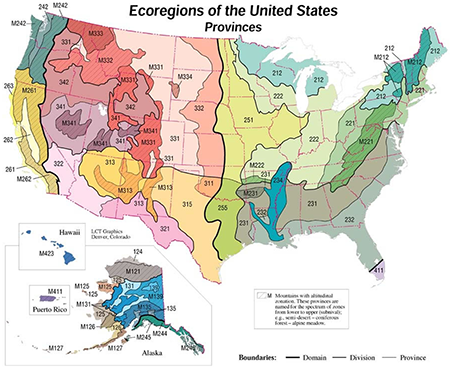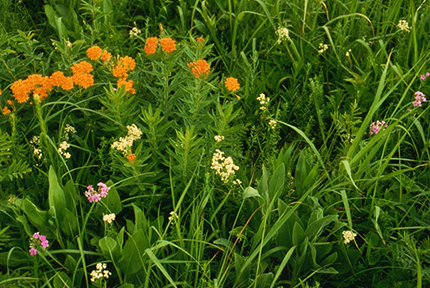
New Handbook Helps States Reduce Vegetation Management Costs and Encourage Native Growth
Roadside vegetation management has long been synonymous with mowing and applying pesticides to plants in the right-of-way. Highway managers, in an attempt to increase road safety by improving sight-lines, have used these tactics since the early days of highway construction. However, this approach is no longer sustainable in many cases due to a number of contributing factors, including rising fuel prices, frequent budget cuts, concerns over pesticide use and carbon emissions, and a growing awareness of the impact of invasive species.
Additional Resources Are Available Online
Vegetation Management: An Ecoregional Approach marks the third and final installment of an FHWA guidebook series on managing roadside ecology.
The first guide, Roadside Use of Native Plants, answers basic questions about the use and preservation of native plants and includes relevant Federal policy; a list of native, endangered, or noxious plants in each State; and a sample specification outlining the use of native species in contracts.
Roadside Weed Management, the second in the series, is a guide to best management practices for invasive species control along roadsides. It includes essays on prevention and control of pest plant invasions, summaries of relevant regulations and policies at Federal and State levels, and State-by-State compilations of noxious species lists and agency contacts.
The Office of Planning, Environment, and Realty has many other resources that help highway managers meet demands related to natural ecosystems. Guides for Federal, State, and local government staff related to vegetation and right-of-way management are available at https://www.fhwa.dot.gov/hep/publications/.
To address this change, the Federal Highway Administration’s (FHWA) Office of Planning, Environment, and Realty has recently released a comprehensive handbook on vegetation management, the third and final installment in a guidebook series on managing roadside ecology that has been earning praise from transportation officials around the United States. Vegetation Management: An Ecoregional Approach was designed as a quick-start guide for maintenance staff from State Departments of Transportation (DOTs), as well as landscape, environmental services, and erosion control personnel. State DOTs have received copies of the guidebook and an e-book version will be available on the website in 2015.
Advancing an Ecoregional Approach
Roadways bisect interconnected landscapes of plant communities called “ecoregions,” which are defined areas of similar geographic, vegetative, hydrologic, and climatic characteristics. If not managed and maintained appropriately, these medians and roadsides quickly turn into eyesores, or worse, breeding grounds for invasive species. Considering the 17 million acres of roadside in the United States, transportation managers face a significant challenge in maintaining this vegetation.
Since the beginning of the highway system, roadside vegetation management has been divided into two separate schools of thought: mow and apply pesticides, or encourage native growth. More accurately, these approaches are referred to as agricultural and ecoregional, respectively. Beginning in the 1930s, many land managers have opted for the seemingly simple and aesthetically pleasing agricultural solution, overlooking the potential benefits of a more efficient approach that could greatly reduce fuel costs, manpower, and stress on the environment.
Now, however, the ecoregional approach has been proposed as an important alternative to agricultural methods for a number of reasons. The ecoregional approach seeks to reintroduce native plants to roadsides for environmental, economic, and even cultural benefits. For instance, the solution restores the country’s roadsides to reflect the natural biodiversity of each region. Other benefits include greater ecological diversity, more suitable habitat for wildlife, improved natural aesthetics, better erosion control, and a reduction in mowing and in water and fertilizer use, which can significantly reduce fuel and other maintenance costs. Less fuel also means less greenhouse gas emissions.
In a field where the agricultural approach has become part of routine policy, the new vegetation management guide represents two decades of work with Federal, State, and municipal maintenance departments to understand how to encourage a more ecological perspective. The guide is unique in that it not only explains why maintenance departments can save costs using ecoregional methods, but also how they can adopt the approach.
Reintroducing Native Plants Step-by-Step
When transitioning away from the agricultural approach, the ecoregional map is perhaps the most important tool in the handbook for land managers. It serves as a starting point from which they can develop a management strategy. For the first time ever, FHWA has collected ecoregion information from all 50 States and Puerto Rico into one guidebook. The recommended approach includes the following steps:

The new vegetation management guide provides an easy reference map to identify the ecoregion in which highway projects are located. (Courtesy of FHWA)
- Use the ecoregional map to identify the ecoregion in which the project is located.
- Contact the State’s Natural Heritage Program to find a preserve or natural area typical of that region.
- Visit the preserve or natural area to better understand the plant communities and species common there.
- Ask the Natural Heritage Program for a plant inventory list of the preserve, which can include a seed mix that is hardy to the area and matches the site. Designing the right seed mix is crucial, as different species play different roles. Planters should be keenly aware of these roles and try to combine them in a way that strikes the ideal balance. This especially pertains to grasses and forbs, which lay the foundational groundcover for an ecoregion.
- Plant the recommended seed mix in the roadsides and medians and encourage its growth through methods appropriate to that plant community.
Although a reduced emphasis on mowing and landscaping is the defining characteristic of the ecoregional approach, the guide also includes the necessity of vegetation management staples like basic spraying strategies, invasive plant control, and instructions for a prescribed burn. The guide serves as a starting point and acknowledges that any given agency may need to employ unique methods for a specific ecoregion.

The ecoregional approach seeks to reintroduce native plants to roadsides for economic and environmental benefits. (Courtesy of FHWA)
Additionally, to help agencies adjust to this style of management, the guide includes practical applications of the ecoregional approach. Nebraska, for instance, has already implemented an integrated ecoregional plan for its vegetation management responsibilities, abandoning many default tactics like mowing and applying pesticides. The guide describes in detail how Nebraska State officials have carried the ecoregional approach from research to practice, with the goal of making built and natural environments compatible and sustainable. State officials have even successfully enlisted the help of a goat herd to naturally manage vegetation. About 3,000 goats grazed at two sites, removing unwanted vegetation while leaving the beneficial wetland vegetation—an unconventional but effective and sustainable form of selective removal that chemicals could not accomplish. The guidebook also includes a detailed breakdown of Nebraska’s ecoregions according to climate, hydrology, soil types, plant communities, and other relevant characteristics, which can help other land managers to analyze their own ecoregions.
Handbook Teaches Ecological and Cost-Effective Vegetation Management Techniques
Vegetation Management: An Ecoregional Approach is a recent example of FHWA’s commitment to cost-effective sustainability. FHWA encourages State land managers to adopt an ecoregional approach to better manage roadside vegetation, and the guide provides practical advice to help them accomplish this. The examples and instructions found in the guide make clear that, by using native plants in highway projects, States can save fuel and other maintenance costs while reducing their environmental impact.
Contact Information
Bill Ostrum
Office of Project Development and Environmental Review
Federal Highway Administration
(202) 366-4651
william.f.ostrum@dot.gov
Ron Poe
Project Planning and Development Division
Nebraska Department of Roads
(402) 479-4499
ronald.poe@nebraska.gov
Look What’s New!
- FHWA is now accepting applications for the 2015 Environmental Excellence Awards. Nominations are due by September 30, 2014.
- The U.S. Department of Housing and Urban Development, U.S. Department of Transportation, and U.S. Environmental Protection Agency recently released a report documenting the lessons learned thus far from the Partnership for Sustainable Communities. The publication summarizes how important policy changes and key collaborations have made significant impacts on communities. To view the report, click here.
- The National Highway Institute (NHI) announces that the updated training FHWA-NHI-134080/Environmental Factors in Construction and Maintenance is now available. This course emphasizes common environmental agency regulations, adherence to plans, potential for unexpected issues, and more. To view the course details click here.
- The Council on Environmental Quality published draft guidance regarding the use of programmatic reviews under the National Environmental Policy Act. Click here for more information.
Successes in Stewardship is a Federal Highway Administration newsletter highlighting current environmental streamlining and stewardship practices from around the country. Click here to subscribe, or call 617-494-3539 for more information.

